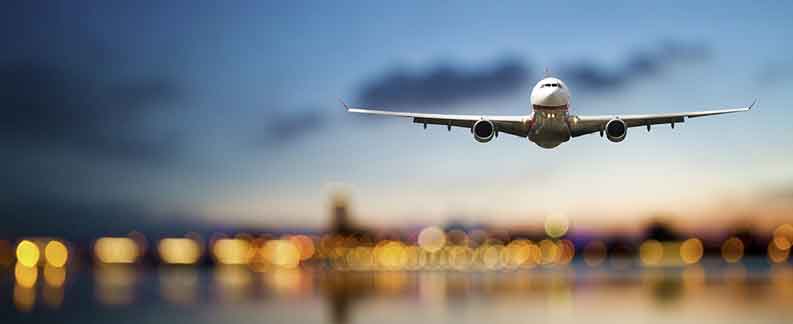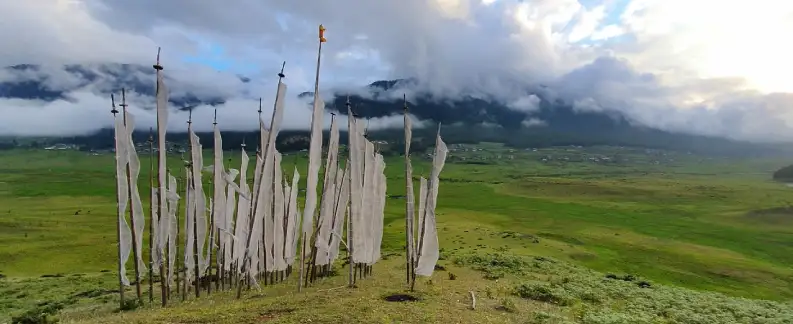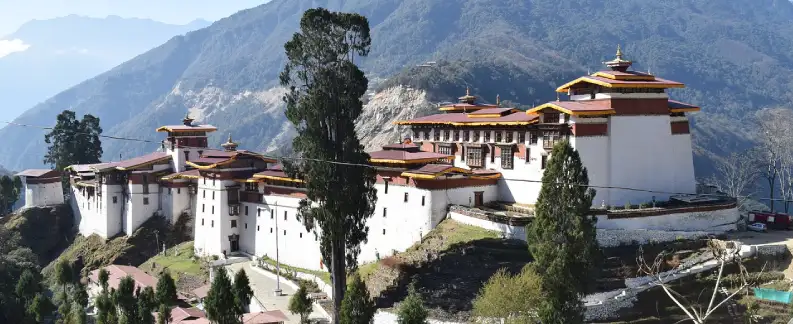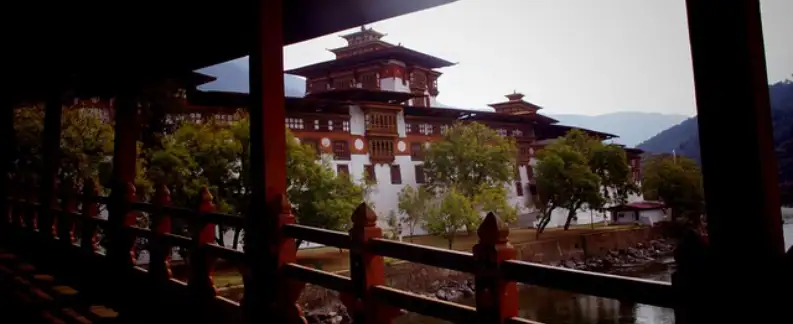Bhutan Tour - Discover Bhutan
The flight to Paro is one of the most spectacular in entire Himalayas. Flying along the Himalayan range from Kathmandu, the journey offers fascinating views and an exciting descent into the Kingdom. Bhutan’s first gift, as you disembark from the aircraft will be cool, clean fresh mountain air. After immigration formalities and baggage collection, you will be met by our representative, and afterwards drive to Thimphu, the capital town of Bhutan with enroute stop at Chuzom, the confluence of Thimphu and Paro rivers. Three different style of stupas; Tibetan, Nepalese and Bhutanese adorn this confluence. Shortly before reaching Chuzom, you will see on your left TschogangLhakhang, “the temple of the excellent horse”. It is a private temple, built in 15th century, as the result of visitation from Balaha, the excellent horse, a manifestation of Chenrezig, the compassionate Buddha.
On arrival in Thimphu, check into the hotel. The capital town of Bhutan and the centre of Government, religion and commerce, Thimphu is a unique city with unusual mixture of modern development alongside ancient traditions. With the population of about 90,000 it is perhaps still the world’s only capital city without a traffic light.
Evening an exploratory walk around Thimphu Main Street and market area. Also visit the Local Crafts Bazaar, to browse through example of Bhutan's fine traditional arts. Here you can buy hand-woven textiles, Thangkha paintings, masks, ceramics, slate and wood carvings, jewellery, interesting items made from local materials.
Overnight at the hotel in Thimphu (Altitude 2400m).

After breakfast, visit Buddha Point (Kuensel Phodrang). Located at a short drive from Thimphu city centre, visitors can get a good overview of the Thimphu valley from the Buddha point (KuenselPhodrang). You can pay your obeisance and offer prayers to the Buddha, the largest statue in the country and then walk around and take a glimpse of the valley.
Commence the “Buddha Nature Train” from Buddha point to Changangkha Lhakhang (02 hours easy hike). The hike from Buddhapoint to Changangkha Lhakhang is the most popular one to see the locals of Bhutan and at the same time take a forest bath. As you hit the trail you will be greeted by thousands of prayer flags and welcomed by a pristine forest of pines, birch, and rhododendron trees. If you are lucky, you can encounter few wild pheasant and bore. The trail is well maintained and at some places along the trails Gazebos are set up from where you can have a spectacular view of Thimphu valley and ends at Changangkha Lhakhang.
Continue visit the Changangkha Lhakhang, which is a fortress like temple and monastic school perched on a ridge above Thimphu, south of Motithang. The temple was established in 12th century on a site chosen by Lama PhajoDrugomShigpo, who came from Tibet. The central statue here is Chenrezig in a manifestation with 11 heads. From temple courtyard, there is fascinating view of Thimphu valley.
After lunch, take a short drive (15 km) to Pangri Zampa, 16th century one of the oldest monasteries in Bhutan located just north of Thimphu. Here is a monastic school where Buddhist student’s monks learn Lamaism and astrology based on Buddhist philosophy.
Late afternoon, visit Trashichhoedzong: This impressive fortress/monastery houses Secretariat building, the throne room of His Majesty, the King and various government offices. It is also the summer residence of Chief Abbot and central monk body.
Evening an exploratory walk around Thimphu Main Street and market area. Also, visit the Local Crafts Bazaar, to browse through example of Bhutan's fine traditional arts. Here you can buy hand-woven textiles, Thangkha paintings, masks, ceramics, slate and woodcarvings, jewellery, interesting items made from local materials.
Overnight at the hotel in Thimphu.
After breakfast, check-out from the hotel & drive Gangtey (Phobjikha) enroute visiting Dochula Pass (Altitude 3080m). In Bhutan, the passes are marked by a large Bhutanese Chorten and prayer flag. Dochula pass offers the most spectacular view over the high peaks of the eastern Himalayas on a clear day. And also via Wangdue Phodrang, where you can visit the local market and explore newly developed town. The district of Wangdue Phodrang is also famous for its bamboo products, slate and stone carvings. Further ahead pass through dense forests and oak, rhododendron tress, reaching at Gangtey (Phobjikha).
The valley of Gangtey is one of the most beautiful spots in Bhutan. The surprise of finding such a wide, flat valley without any trees after the hard climb through dense forests is augmented by an impression of vast space, and extremely rare experience in Bhutan where most of the valleys are tightly enclosed.
After lunch, take a walk around Gangtey village and visit Gangtey Goempa. Perched on a small hill that rises from the valley floor, the Gangtey Monastery is the only Nyingmapa monastery on the western side of the Black Mountain’s Gangtey valley, Bhutan and also the biggest Nyingmapa monastery in Bhutan. The Monastery is surrounded by a large village inhabited mainly by the families of the 140 Gomchens who take care of the Monastery.
Overnight at the hotel in Gangtey

After early breakfast, enjoy the Gangtey Nature Trail (Distance: 5.5 km, Time: approx. 2 hours, Difficulty level: Easy).
This pleasurable walk provides opportunity to get nice feel of Phobjikha valley. From the small hilltop overlooking Gangtey Goemba, you head downhill through flower meadows to Semchubara village and from here through beautiful forests and into open valley. The trail ends at the local community school after passing a chorten and Khewal Lhakhang.
After breakfast drive to Trongsa across Pelela pass (3100m), enroute visit to Chendbji Chorten, the stupa patterned on Swayambhunath in Kathmandu with eyes painted at four cardinal points. It was built in the 18th century by Lama Shida from Tibet, to cover the remains of an evil spirit that was subdued at this spot.
Upon arrival at Trongsa; check into the hotel. Rest of the day is at leisure.
Overnight at the hotel in Trongsa
After breakfast, check-out from the hotel and visit the striking Trongsa Dzong, ancestral abode of Bhutan’s royal family. Built in 1648 as the seat of power over central and eastern Bhutan. Both the first and second kings of Bhutan ruled the country from this ancient seat. All four kings were invested as Trongsa Penlop ('governer') prior to ascending the throne. The Dzong is a massive structure with many levels, sloping down the contours of the ridge on which it is built and then visit the Ta Dzong, standing on the side of the mountain and built to guard Trongsa.
Later continue drive to Bumthang across Yutong la pass (3,400m). Enroute visit Chumey valley and Yathra (woolen fabric) weaving center and villages.
On arrival in Bumthang; Check-into the hotel. Bumthang is one of the most spectacular valleys in Bhutan and also the heartland of Buddhism. 29 kms ahead of Trongsa cross Yutongla pass (3,400m) and from here again the landscape looks different and dense forests of conifers stretches. The arrival of Bumthang begins with wide, open cultivated Chumey valley.
Overnight at the hotel in Bumthang

After breakfast proceed for the tour of Bumthang valley: visit Kurje Lhakhang, where the saint Padma Sambhava subdued a local demon and left his body imprint on a rock, the Jambey Lhakhang (7th century temple), Tamshing Lhakhang (housing some of the oldest wall paintings in Bhutan) and Jakar Dzong (administrative center of the region). Stroll in the village, visit the little handicrafts shop at the entrance to the town, and perhaps take refreshments at a local restaurant.
Afternoon take a short hike to Lhodrak Kharchhu Monastery: Located above the main town, about 3 km from Chamkhar town, the monastery was founded by Namkhai Nyingpo Rinpoche in 1984 who was recognized at a very young age by H.H. the 14th Dalai Lama and H.H. 16th Karmapa as the reincarnation of a Tibetan lama.
The monastery has become part of an extensive effort to preserve and revitalize Tibetan culture. The monk’s regular curriculum includes reading, memorizing the daily prayers, learning dharma dances, drawing mandalas, learning the melodies of sacred rituals, learning the use of ceremonial instruments and the art of making sacrificial objects, grammer, poerty, karika along with the basics of contemplation and instruction on the different stages of tantra.
Overnight at the hotel in Bumthang (Altitude 3000m).
After breakfast, check-out from the hotel and drive to Punakha, the old capital town of Bhutan.
On arrival in Punakha; Check-into the hotel. Later visit Punakha Dzong, a massive structure built at the junction of two rivers. It was the capital of Bhutan until 1955, and still serves as the winter residence of the monk body.
Overnight at the hotel in Punakha
After breakfast, take short hike to Chimi Lhakhang (from hotel it is about 15 minutes’ drive till motorable road and then walk starts through paddy fields and villages. This is total about 1½ hour walk, including both way). The Chimi Lhakhang, situated on a hillock in the centre of the valley, also known as the temple of fertility. It is widely believed that couples who do not have children and wanting one, if they pray at this temple, they are usually blessed with a child very soon. The trail leads across rice fields to the tiny settlement of Pana, meaning ‘field’.
Later continue drive to Paro along scenic highway, enroute visit SimtokhaDzong, the oldest fortress of the country built in 1627 which now houses the School for Buddhist studies.
On arrival in Paro, check into the hotel. After lunch, proceed to visit Ta Dzong, originally built as Watchtower, which now houses National Museum. The extensive collection includes antique Thangkha paintings, textiles, weapons &armour, household objects and a rich assortment of natural and historic artifacts.
Ta Dzong visit immediately followed by a short walk down the trail to visit Rinpung Dzong (ParoDzong), meaning (“fortress of the heap of jewels”), which has a long and fascinating history. Along the wooden galleries lining the inner courtyard are fine wall paintings illustrating Buddhist lore such as four friends, the old man of long life, the wheel of life, scenes from the life of Milarepa, Mount. Sumeru and other cosmic Mandala.
Overnight at the hotel in Paro.

After breakfast excursion to Taktshang Monastery or Tiger’s Nest (approx. 5 hours walk): It is one of the most famous of Bhutan’s monasteries, perched on the side of a cliff 900m above the Paro valley floor. It is said that Guru Rinpoche arrived here on the back of a tigress and meditated at this monastery and hence it is called ‘Tiger’s Nest’. This site has been recognised as a most sacred place and visited by ShabdrungNgawangNamgyal in 1646 and now visited by all Bhutanese at least once in their lifetime. On 19 April, 1998, a fire severely damaged the main structure of building but now this Bhutanese jewel has been restored to its original splendour.
Afternoon drive to Drukgyel Dzong, a ruined fortress where Bhutanese warriors fought Tibetan invaders centuries ago. The snowy dome of sacred Chomolhari, "mountain of goddess'' can be seen in all her glory from the approach road to the Dzong.
Evening, visit the 7th century Kyichu Lhakhang, one of the 108 temples built in the Himalayas by Tibetan King, Songtsen Gampo. The building of this temple marks the introduction of Buddhism in Bhutan.
Overnight at the hotel in Paro.
Copyright © 2016 - 2023, Trinetra Tours Pvt Ltd. Powered By DigiLantern

